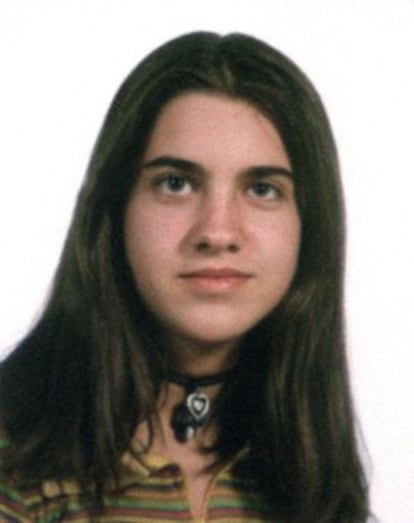The idyllic hideout of Madrid teenager’s suspected murderer
The wife and neighbors of the man alleged to have killed Eva Blanco in 1997 are still in shock

A municipality of 1,500 residents in the corner of northeast France, Pierrefontaine-les-Varans looks like any other quiet Swiss-French village. Only 20 kilometers from the border with Switzerland, the town is filled with single family homes built to weather the heavy winter snow.
The residents of this otherwise sleepy village were shocked last week when they discovered that one of these homes hid a notorious fugitive.
Ahmed Chehl Gerj, 52, was arrested on Thursday for the 1997 murder of Eva Blanco Puig. The 17-year-old student was raped and stabbed to death as she walked home from a nightclub in Algete (Madrid).
I want to speak to him soon. I want him to tell me what happened. He has to tell me”
Fatima, Ahmed’s 36-year-old wife
“God exists, and there will be justice,” says Fatima, his 36-year-old wife, who has been shaken by the news of her husband’s alleged past.
Fatima met Ahmed in Besançon, about 50 kilometers from Pierrefontaine, where she moved to study electronics. She planned on returning to Morocco but ended up marrying him in 2003.
Petite and thin, Fatima appears timidly at the doorway to answer the bell. Her house – also a single family unit – is one of the less luxurious in the town.
“Poor, girl, poor girl, Eva Blanco, Eva Blanco,” she cries, repeating the victim’s name.
At first, she is reluctant to talk, but she eventually invites EL PAÍS into her home.

Ahmed and Fátima purchased the house in June after having rented it for a number of years. Despite what has happened, she says she doesn’t think she will have any problems keeping up with the payments thanks to her job as an electronics expert. A garden project started by Ahmed before his arrest has been left unfinished.
“He’s a good father and a good husband,” says Fatima of her also Moroccan spouse. Since he was taken by French police to Besançon to await extradition, Fatima has not spoken to him.
“I want to speak to him soon. I want him to tell me what happened. He has to tell me,” she insists.
Fatima would like to think that maybe the arrest of the father of her two children is all a big mistake.
Ahmed left Algete in 1999, leaving behind two sons and a daughter he had with Encarnación Cantos Sánchez, his previous wife who also now lives in Besançon.
Ahmed and Fatima have two young children, including a six-year-old boy.
“We would hardly talk about Algete,” Fatima says. “The times we would go to Spain, we would head directly to his brother’s home on the coast and never went through Madrid. We would go on directly to Morocco.”
For her part, his first wife Encarnación is also confused.
“Nothing makes sense to me – the dates, the evidence, the cars the police said he owned. It seems so strange to me. He never mistreated me nor my daughter,” says Encarnación, who is still legally married to Ahmed under Spanish law and was receiving €200 in child support from him.
Since his arrest, she has been unable to see him.
Ahmed worked as a welder and, until two years ago, held a job with a farm machinery manufacturer, Sermap, in Pierrefontaine.
“He didn’t get along with his co-workers; they would bother him,” says Yvan, a local pharmacist.
Nevertheless, Ahmed was known to be kind and friendly throughout the community.
When he was arrested last Thursday by French police and the Civil Guard, witnesses said he appeared to be in shock – he had been keeping a terrible secret for the last 18 years.
François Cucherrousset, the mayor of Pierrefontaine-les-Varans, says he has also been taken aback by last week’s events.
Ahmed left Algete in 1999, leaving behind two sons and a daughter he had with his previous wife
“Everything was normal here. His eldest son is in school, the small one, who was born last year, is not even a year old,” says the mayor, who also asks for more details about the case.
“How did they finally track him down? I read something about DNA evidence, but did the police have this all this time?”
It was the Civil Guard’s homicide unit that worked hard to try to solve the case before the statute of limitations could run out on April 20, 2017 – 20 years after the crime.
“Really?” asks the mayor. “Then there is justice.”
English version by Martin Delfín.
Tu suscripción se está usando en otro dispositivo
¿Quieres añadir otro usuario a tu suscripción?
Si continúas leyendo en este dispositivo, no se podrá leer en el otro.
FlechaTu suscripción se está usando en otro dispositivo y solo puedes acceder a EL PAÍS desde un dispositivo a la vez.
Si quieres compartir tu cuenta, cambia tu suscripción a la modalidad Premium, así podrás añadir otro usuario. Cada uno accederá con su propia cuenta de email, lo que os permitirá personalizar vuestra experiencia en EL PAÍS.
¿Tienes una suscripción de empresa? Accede aquí para contratar más cuentas.
En el caso de no saber quién está usando tu cuenta, te recomendamos cambiar tu contraseña aquí.
Si decides continuar compartiendo tu cuenta, este mensaje se mostrará en tu dispositivo y en el de la otra persona que está usando tu cuenta de forma indefinida, afectando a tu experiencia de lectura. Puedes consultar aquí los términos y condiciones de la suscripción digital.
More information
Últimas noticias
Most viewed
- Sinaloa Cartel war is taking its toll on Los Chapitos
- Oona Chaplin: ‘I told James Cameron that I was living in a treehouse and starting a permaculture project with a friend’
- Reinhard Genzel, Nobel laureate in physics: ‘One-minute videos will never give you the truth’
- Why the price of coffee has skyrocketed: from Brazilian plantations to specialty coffee houses
- Silver prices are going crazy: This is what’s fueling the rally










































